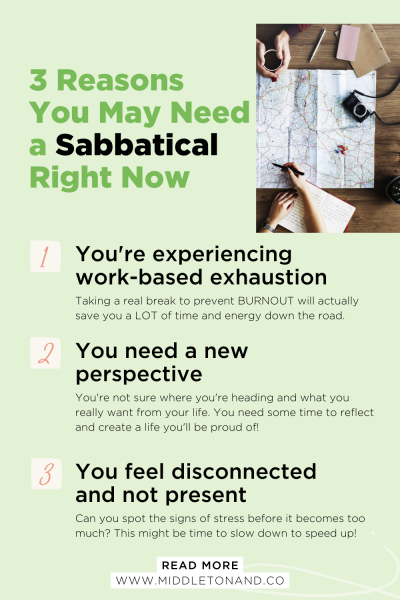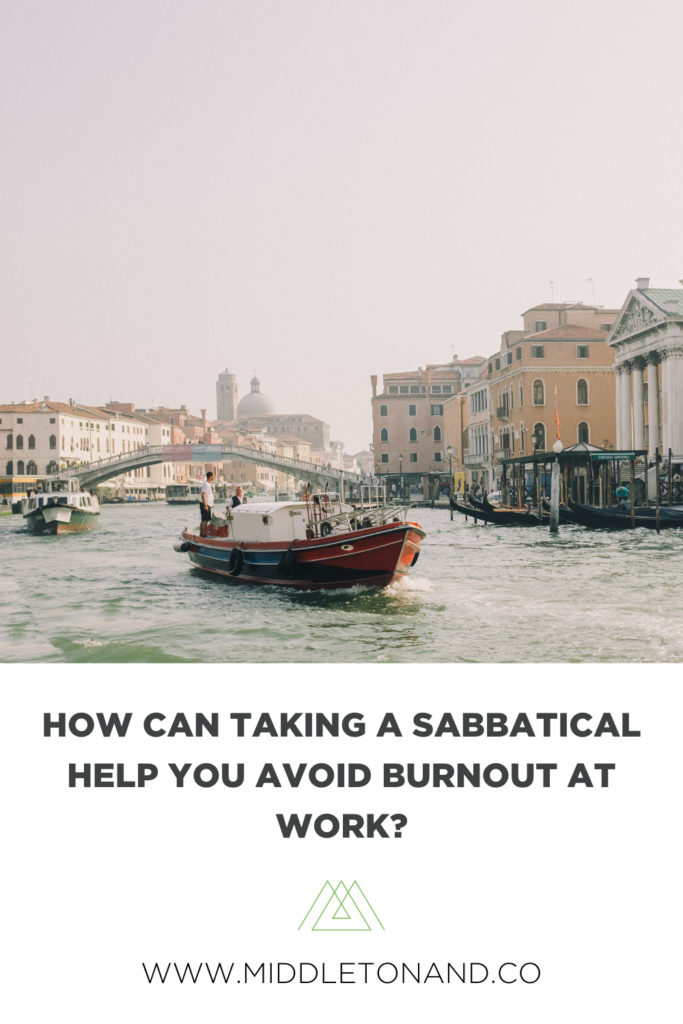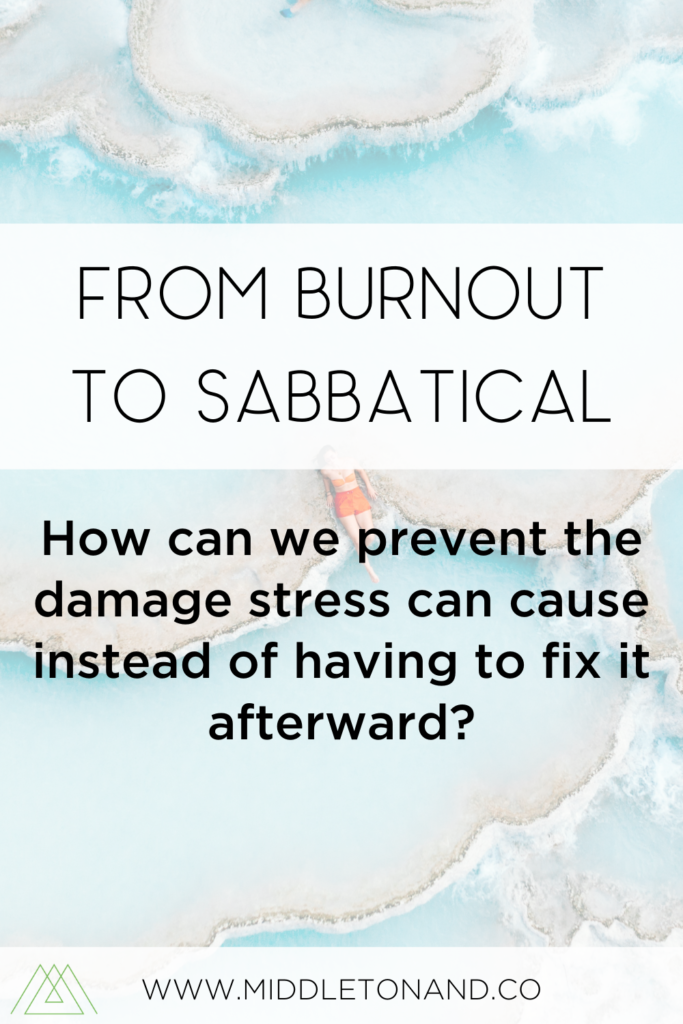A lot of people take a sabbatical to rest and heal after a burnout. But can a sabbatical prevent burnout instead?
If sabbaticals are a great way to heal from work-based exhaustion, they are even better when used in prevention!
What if the new word for our generation wasn’t burnout but sabbatical?
Day in and day out, we show up, work hard, and try our best to live as best we can. We work to achieve not only our own personal goals, but those of our employer as well. Well, this definitely sounds like a potential recipe for burnout, doesn’t it!
Burnout is the result of doing too much, too fast, and for too long without ever taking the time to stop and reassess.

Let’s look a little bit deeper into what burnout actually is because it can affect anyone and any part of our lives.
We can experience emotional burnout, physical burnout, energy burnout, career burnout, relationship burnout – it can impact pretty much every part of life.
While they are all interconnected, we are focusing mostly on career burnout, which tends to lead to physical, emotional, and energetic burnout when ignored. Burnout has been defined as “a syndrome of emotional exhaustion and a sense of low personal accomplishment that leads to decreased effectiveness at work.” When we work too hard, for too long, the body and mind simply cannot sustain it anymore. We run ourselves down to the point we have no choice but to take time off to heal.
The most common signs of burnout include:
- Feeling tired or drained most of the time
- Feeling helpless, trapped, and/or defeated
- Feeling detached/alone in the world
- Having a cynical/negative outlook
- Self-doubt
- Procrastinating and taking longer to get things done
- Feeling overwhelmed
But why is burnout the new word for our generation?
We live in a society where overworking is often celebrated, and even encouraged. The team member who stays late to get the job done, or the person who consistently skips their lunch break to move things forward, is often the person who is the most praised. Boundaries no longer exist – no more “leaving work at work” with emails being accessed on our phone at any time of the day (and night) and meetings being hosted over ZOOM from the “comfort of our own home.”
But we want your badge of honor to be given to you based on how focused, creative, and calm you are at work, not for how exhausted, overworked, and stressed you are.
And if that’s the case, then something desperately needs to change!
We believe you can be passionate about your work and about your personal life at the same time! We believe you can excel in your career without costing you your social and family life and your health!
Imagine if we stopped responding to “How are you doing?” by “Good, just super busy and tired” and instead said, “Awesome, just had a really relaxing weekend and I’m excited about what’s on the agenda at work this week!”
When it comes to taking a sabbatical, many often only consider it when they reach burnout or sense that it is near. Many people view sabbaticals as the magic potion to fix their stress and reset both their personal and professional life. While it sure can help get you back on your feet after such a stressful time, we want to challenge you to see sabbaticals not as a cure but as a preventive solution!
Our mission is to encourage people to consider taking a sabbatical way before the burnout stage.
Should you take a sabbatical or a vacation?
The terms “sabbatical” and “vacation” are sometimes used interchangeably, yet they’re different.
While they both indicate time off that professionals take from work, it’s important to understand how they differ.
Most companies in the US offer two weeks vacation per year. This paid time-off is intended for a quick break, to put some obligations on hold for a few days to rest, or do something other than work. But you’re not going to change your life in 2 weeks! It’s expected that once you return from your vacation, your work and life will simply resume where you left off. That also means that any problems, anxiety, stress left on your desk before your vacation will be waiting for your return. Or even compounded from you taking time off!
A sabbatical on the other hand can be anywhere from four weeks to one to two years. The length entirely depends on the circumstances of the individual, who may or may not be planning on returning to their same job afterward. And this sabbatical time-off is much more intentional than a vacation. It is a precious time in your life to reassess multiple aspects of your lifestyle, to align to your purpose, and to create a life you feel really good about!
A big hindrance to people taking a sabbatical is that they often wait until they are entirely worn out to do it. The problem there is that putting all the pieces back together is a lot harder after everything has already exploded.
Imagine taking time to reassess your life and your goals when you actually have the energy to do it instead of doing it when you can’t even think straight. If you wait to be in burnout mode to take a sabbatical, most of your time away will be spent trying to just get yourself back on your feet.
We believe in supporting people to create a lifestyle that serves them, and this includes taking a break before burnout knocks on your door.
Learn more about the difference between a vacation and a sabbatical here. Discover which one you actually need!
What if sabbaticals were an intentional part of your career? Let’s prioritize your wellbeing!
Many people are unhappy at work, but just continue head down in the daily grind.
But times are slowly changing. Even before COVID-19 hit, more people were beginning to acknowledge the benefits of taking leave to improve their mental wellbeing.
So let’s take a look at some of the benefits of sabbaticals in relation to mental health.

Can a sabbatical prevent burnout? 3 reasons we are convinced it does!
1. Tackle work-based exhaustion before burnout hits
If you think you may be experiencing work-based exhaustion, it’s important to tackle it early on. It doesn’t help to simply push through and hope for improvement. For many, it can lead to more significant issues in the long run. Looking into your sabbatical options early on is a great way to begin to prioritize your wellbeing. We truly believe that taking a break before burnout hits is a step in the right direction. And we aren’t alone.
Millennial and Generation-Z employees are leaving jobs due to mental health. According to Mind Share Partners’ “Mental Health at Work 2019” report, 50% of Millennial and 75% of Generation-Z workers reported having left a job due, at least in part, to mental health reasons, as compared with just 10% of their Baby Boomer counterparts. These findings align with generational trends in 2020 regarding awareness around mental health issues.
We underestimate the effect work exhaustion can have on our mind and body. And we surely underestimate how long it takes to recover from it! As counterintuitive as it may seem, taking a real break to prevent it will actually save you a LOT of time and energy down the road.
2. Gain a new perspective on life
Work-related stress can affect anyone, no matter their age or where they are in their career path. Disconnecting from work, for more than a couple of weeks, can help you gain a perspective of life outside work and gives you the opportunity to reset mentally. You can take the time to deeply think about your job, your career, and what you really want for your life.
After all, we only have this one life. So how do you really want to spend it?
A sabbatical blocks out time for you to ask the question: if you could do anything, what would you do? Where would you be? You might be surprised by the answers!
If you’re worried about leaving your company behind, remember that you are less of an asset to your company when you are fatigued, frazzled, and exhausted.

3. Gain a new level of self-awareness
Can you spot the signs of stress before it becomes too much? Often when we are busy rushing around, we can miss those early signs the body and mind give us to let us know that they’re struggling to keep up.
Let’s be honest, how many times have you passed your exit on the freeway because you were not really present as you were driving? Or walked into another room for something, and by the time you got there forgot what you were looking for. Or poured your coffee into your cereal bowl rather than into the mug sitting right next to it on the kitchen counter…
Taking a work break can give you time for some self-connection. Time to be intentional. Time to be present. The phrase ‘slow down to speed up’ is a great reminder of the power of true rest. After all, there is a whole world out there to experience! Or maybe you simply could do with a break a little closer to home. Regardless of your destination, know that it’s important for your mental health to check out your options and set aside some time to “shut off.”
What is clear is that the workplace landscape is changing. Imagine the quality of your life if you took a break while you still had some energy to enjoy it!

We strive to support people to use their sabbatical time for regeneration, motivation, and enjoyment, as opposed to a time to heal work-related burnout and stress. Prevention instead of treatment is a motto we love.
If you are unsure about where to start, get in touch today. Here at Middleton & Company, we help our clients with their sabbatical planning – from the financial planning aspect to helping them get ready, set purposeful goals, enjoy the journey, and get prepared for their return. We look at sabbatical as an intentional part of your life and career, not just parentheses.
To learn more about what we do and why working with a financial planner on your sabbatical is beneficial, click here.
Not sure if a sabbatical is what you need right now? Download our free guide: “How to know when it’s time to quit your job and travel the world“
Like this article? Make sure to Pin It so you can go back to it later!



